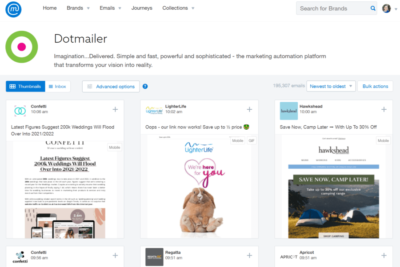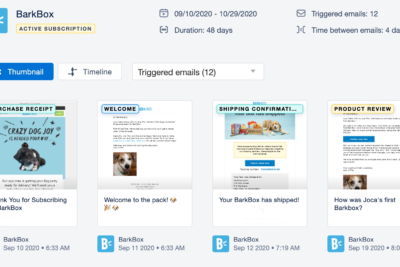Email is a crucial tool for brands that are introducing a brand-new product line. We saw this when Lululemon heralded the arrival of its new footwear line in March with a clever two-email campaign focused on the first offering, its Blissfeel running shoe.
Why email? Because it gives marketers plenty of space to display the message, a wider choice of design and copy options, and the all-important access to customers’ personal inboxes. All these factors help a brand pump up curiosity and enthusiasm for the launch.
A quick look at Lululemon’s initial campaign using MailCharts data shows how the brand used a combination of approaches to whet customers’ appetites:
Lululemon’s first email, at the left below, uses both bold and subtle animations and precise copy to highlight product details to intrigue seasoned runners. It went out March 10, about 2 weeks before the shoe dropped, and on a Wednesday, one of the brand’s regular sending days according to MailCharts calendar data.
The second email, right below, launched on Tuesday, March 22, the day the shoe went on sale, and plays on emotions rather than product benefits.

The two emails together show how to use email to drum up enthusiasm for a brand-new product, which requires a different approach from introducing a new seasonal collection or product extension. If your email team wants to make a big splash with a new product or new-collection campaign, email, a deeper dive into the email data will reveal plenty of useful findings.
As an example, Lululemon’s email data shows how the brand created a distinctive campaign without disrupting its regular email program. Both campaign emails featured design and copy that fit in harmoniously with its regular campaigns, which emphasize products over promotions.
Compared to similar brands in industry groups like Activewear Apparel, Sports & Activities, and Running, Lululemon sends fewer campaigns (~3 per week on average) and fewer promotions in those campaigns (an average 18% promotion rate in Q1 2022, although that’s up exponentially from a year ago).
We detected a small spike in both email volume and promotions in the same weeks the brand launched its shoe-line emails but overall, Lululemon is sending 15% fewer weekly email campaigns compared with a year ago.

What brands can learn from Lululemon
Lululemon’s 2-email campaign to launch its shoe line stands out because the brand took two distinctly different approaches in its two-email email campaign. MailCharts users who are researching product-launch campaigns can check out the “Introducing New Collection” list, a hand-curated group of 152 emails from top e-commerce brands, each one featuring a notable product or collection launch.
To make campaign planning even more useful, MailCharts users can either share the list with their teams or create their own personal or team lists. Team members also can comment on any email added to a team list, which keeps all the brainstorming in one easily accessible location.



